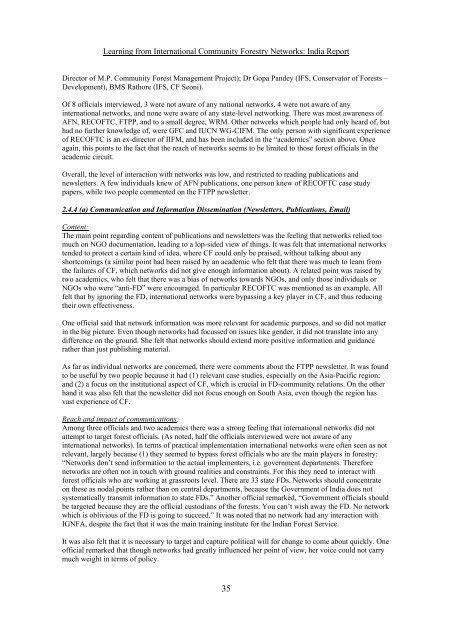Snapshots of International Community Forestry Networks: Country ...
Snapshots of International Community Forestry Networks: Country ...
Snapshots of International Community Forestry Networks: Country ...
You also want an ePaper? Increase the reach of your titles
YUMPU automatically turns print PDFs into web optimized ePapers that Google loves.
Learning from <strong>International</strong> <strong>Community</strong> <strong>Forestry</strong> <strong>Networks</strong>: India Report<br />
Director <strong>of</strong> M.P. <strong>Community</strong> Forest Management Project); Dr Gopa Pandey (IFS, Conservator <strong>of</strong> Forests –<br />
Development), BMS Rathore (IFS, CF Seoni).<br />
Of 8 <strong>of</strong>ficials interviewed, 3 were not aware <strong>of</strong> any national networks, 4 were not aware <strong>of</strong> any<br />
international networks, and none were aware <strong>of</strong> any state-level networking. There was most awareness <strong>of</strong><br />
AFN, RECOFTC, FTPP, and to a small degree, WRM. Other networks which people had only heard <strong>of</strong>, but<br />
had no further knowledge <strong>of</strong>, were GFC and IUCN WG-CIFM. The only person with significant experience<br />
<strong>of</strong> RECOFTC is an ex-director <strong>of</strong> IIFM, and has been included in the “academics” section above. Once<br />
again, this points to the fact that the reach <strong>of</strong> networks seems to be limited to those forest <strong>of</strong>ficials in the<br />
academic circuit.<br />
Overall, the level <strong>of</strong> interaction with networks was low, and restricted to reading publications and<br />
newsletters. A few individuals knew <strong>of</strong> AFN publications, one person knew <strong>of</strong> RECOFTC case study<br />
papers, while two people commented on the FTPP newsletter.<br />
2.4.4 (a) Communication and Information Dissemination (Newsletters, Publications, Email)<br />
Content:<br />
The main point regarding content <strong>of</strong> publications and newsletters was the feeling that networks relied too<br />
much on NGO documentation, leading to a lop-sided view <strong>of</strong> things. It was felt that international networks<br />
tended to protect a certain kind <strong>of</strong> idea, where CF could only be praised, without talking about any<br />
shortcomings (a similar point had been raised by an academic who felt that there was much to learn from<br />
the failures <strong>of</strong> CF, which networks did not give enough information about). A related point was raised by<br />
two academics, who felt that there was a bias <strong>of</strong> networks towards NGOs, and only those individuals or<br />
NGOs who were “anti-FD” were encouraged. In particular RECOFTC was mentioned as an example. All<br />
felt that by ignoring the FD, international networks were bypassing a key player in CF, and thus reducing<br />
their own effectiveness.<br />
One <strong>of</strong>ficial said that network information was more relevant for academic purposes, and so did not matter<br />
in the big picture. Even though networks had focussed on issues like gender, it did not translate into any<br />
difference on the ground. She felt that networks should extend more positive information and guidance<br />
rather than just publishing material.<br />
As far as individual networks are concerned, there were comments about the FTPP newsletter. It was found<br />
to be useful by two people because it had (1) relevant case studies, especially on the Asia-Pacific region;<br />
and (2) a focus on the institutional aspect <strong>of</strong> CF, which is crucial in FD-community relations. On the other<br />
hand it was also felt that the newsletter did not focus enough on South Asia, even though the region has<br />
vast experience <strong>of</strong> CF.<br />
Reach and impact <strong>of</strong> communications:<br />
Among three <strong>of</strong>ficials and two academics there was a strong feeling that international networks did not<br />
attempt to target forest <strong>of</strong>ficials. (As noted, half the <strong>of</strong>ficials interviewed were not aware <strong>of</strong> any<br />
international networks). In terms <strong>of</strong> practical implementation international networks were <strong>of</strong>ten seen as not<br />
relevant, largely because (1) they seemed to bypass forest <strong>of</strong>ficials who are the main players in forestry:<br />
“<strong>Networks</strong> don’t send information to the actual implementers, i.e. government departments. Therefore<br />
networks are <strong>of</strong>ten not in touch with ground realities and constraints. For this they need to interact with<br />
forest <strong>of</strong>ficials who are working at grassroots level. There are 33 state FDs. <strong>Networks</strong> should concentrate<br />
on these as nodal points rather than on central departments, because the Government <strong>of</strong> India does not<br />
systematically transmit information to state FDs.” Another <strong>of</strong>ficial remarked, “Government <strong>of</strong>ficials should<br />
be targeted because they are the <strong>of</strong>ficial custodians <strong>of</strong> the forests. You can’t wish away the FD. No network<br />
which is oblivious <strong>of</strong> the FD is going to succeed.” It was noted that no network had any interaction with<br />
IGNFA, despite the fact that it was the main training institute for the Indian Forest Service.<br />
It was also felt that it is necessary to target and capture political will for change to come about quickly. One<br />
<strong>of</strong>ficial remarked that though networks had greatly influenced her point <strong>of</strong> view, her voice could not carry<br />
much weight in terms <strong>of</strong> policy.<br />
35

















![CynefinFramework final [Read-Only]](https://img.yumpu.com/19017304/1/190x135/cynefinframework-final-read-only.jpg?quality=85)